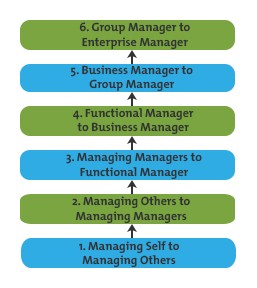What is the leadership pipeline model?
 Leadership crunch is not a recent issue. For years, employers have been complaining about shortage of leaders at various stages. Organization face shortage of quality applicants; as most of them come with shortage of the necessary skills to meet the demand of the organization. The lack of potential leaders is the most pressing human resource challenge organizations are facing today. Among those affected organizations list you will find companies like Xerox, Lucent, JC Penney, Gillette, Texaco and Nissan.
Leadership crunch is not a recent issue. For years, employers have been complaining about shortage of leaders at various stages. Organization face shortage of quality applicants; as most of them come with shortage of the necessary skills to meet the demand of the organization. The lack of potential leaders is the most pressing human resource challenge organizations are facing today. Among those affected organizations list you will find companies like Xerox, Lucent, JC Penney, Gillette, Texaco and Nissan.
When companies go outside to solve their leadership crunch, it gives a wrong signal abut the company that it has not been able to harness and develop leadership inside from among its different ranks. Based on work originally done at General Electric in the 1970s which is referred to as ‘Critical Career Crossroads’ by Walter Mahler, and later expanded to and tested in more than 80 companies, Ram Charan, Stephen J. Drotter and James Noel developed a six-passage model for understanding the leadership requirements in organizations. They published the model in their 2000 book, “The Leadership Pipeline” which they revised in 2011.
The six turns, or passages refer to major events in the life of a leader. Grasping what each passage entails, and the challenges involved in making each transition, will help organizations build a leadership pipeline. It will also help build a leadership culture that will enable the organization to respond to changes and threats in the business environment
The model helps organizations to develop leaders internally at every level; from entry level team leaders to senior managers. The model provides a structure which helps organizations to identify future leaders, assess their aptitude, and help them cross their shortfalls. It helps them plan their development, and measure results. In simple words this models helps in leadership audit at all levels. To take stock of leadership positions for future requirement and train people to go up the leadership ladder. The authors of the book “Leadership pipeline “have more first-hand experience in leadership development and succession planning as they have live experience in various organizations.
Passage one: is known as ‘From managing self to managing others’. Newly recruited young employees spend their first few years in an organization learning and sharpening their skills. They learn expertise required for their job from their supervisor and contribute as an individual employee to the organization. If the organization believes in job rotation, the individual employee is transferred to various desks or department. They contribute to the organization by completing the assigned work within given time frames and in ways that meet objectives. Depending on their performance and contribution and of course their individual skills, they are considered for promotions.
Learning involves planning, punctuality, content, quality and reliability. The recruiters learn to adapt the organizational values and work culture. When people become skilled individual contributors who produce good results, especially when they demonstrate an ability to collaborate, they usually receive additional responsibilities. When they demonstrate an ability to handle these responsibilities and adhere to the company’s values, they are often promoted to first-line manager.
 Passage two: is known as ‘From managing other to managing managers’. At this level the employee is accustomed to company culture and takes on more responsibility. Perhaps the biggest difference between passage one and two is that, at this level, managers must only manage. They need to dissociate from themselves of individual tasks. At this level organizations measure progress of managers based on key result areas, leadership is the main key. Organizations coach the managers beyond their own job description. The managers are given a broad strategic assignment.
Passage two: is known as ‘From managing other to managing managers’. At this level the employee is accustomed to company culture and takes on more responsibility. Perhaps the biggest difference between passage one and two is that, at this level, managers must only manage. They need to dissociate from themselves of individual tasks. At this level organizations measure progress of managers based on key result areas, leadership is the main key. Organizations coach the managers beyond their own job description. The managers are given a broad strategic assignment.
Coaching is the crux at this level because first-line managers frequently don’t receive formal training in how to be a manager. Coaching requires managers to go through the stimulating training program, performance feedback is sought regularly. Trained managers need to train their subordinates; some managers aren’t willing to modify their time in this way. In many organizations, coaching ability isn’t rewarded and the lack of it is not penalized. Hence, it is no wonder that some managers don’t consider coaching as an important mission. People miss an opportunity to learn more because during coaching the trainers themselves learn a lot.
Passage three: This passage is known as – ‘From managing managers to functional managers’. This transition is tougher than it appears. The difference between managing managers and managing a function might apparently look small, but a number of significant challenges hide below the surface. At this level though the manger communicates with an individual executive, it hase an effect on the functionality at least two layers of management. Hence the development of new communication skills becomes mandatory. Functional heads must also manage some areas that are new to them. They must not only attempt to understand this foreign work but learn to value it as well.
At the same time, functional managers report to multifunctional general managers. They therefore need to become skilled in considering other functional needs and concerns. Team work with other functional managers and competition for resources based on business needs are two major skills they must learn. At the same time, managers at this level should learn how to blend the strategy for their own unit with the business’s overall strategy. This means participating in business-team meetings and working with other functional managers, and spending less time on purely functional responsibilities. This is why it is essential that functional managers must learn to delegate responsibility for overseeing many functional tasks.
 Passage four: This passage is known as ‘From functional manager to business manager’. This leadership route is often the most satisfying at times it also becomes challenging for a manager. Business mangers receive considerable autonomy, which people with leadership instincts find liberating. They can clearly see their efforts bringing fruitful results in the organization. At the same time, at this juncture, business managers require a major shift in skills, time applications, and work values. They need to adapt to cross functional thinking though it also requires them to continue developing the abilities embedded at the previous level.
Passage four: This passage is known as ‘From functional manager to business manager’. This leadership route is often the most satisfying at times it also becomes challenging for a manager. Business mangers receive considerable autonomy, which people with leadership instincts find liberating. They can clearly see their efforts bringing fruitful results in the organization. At the same time, at this juncture, business managers require a major shift in skills, time applications, and work values. They need to adapt to cross functional thinking though it also requires them to continue developing the abilities embedded at the previous level.
At this level managers are in charge of combined with integrating functions; whereas at previous level they simply had to understand and work with other functions. The biggest shift comes as they require looking at profitability and sustainability of the business. Managers who are newly promoted to this level of business managers must change the way they think in order to be successful. There are probably more new and unfamiliar responsibilities here than at previous levels. For people who have been in only one function for their entire career, a business manager position represents unexplored territory. At this level managers suddenly become responsible for many unfamiliar functions and outcomes.
Passage five: This passage is called ‘From business manager to group manager’. This level also requires a critical shift in four skill sets. First, group managers must become capable at evaluating strategy for capital allocation and operational functions. This is a sophisticated business skill that involves learning to ask the right questions, grasp, analyze the right data, and apply the right corporate viewpoint to understand which strategy has the greatest probability of success.
This is a leadership passage that at first glance does not seem difficult. The assumption is that if you can run one business successfully, you can do the same for other few businesses. The flaw in this reasoning begins with what is valued at each leadership level. A business manager values the success of his own business. A group manager values the success of other groups too. We realize at this level that some managers think success has come because of his/her own contribution and they try to take the entire credit. It is a drawback of such managers who do not credit others for the success. As a group manager the person must first learn to inspire and motivate others. We see many good business executives at their peak stop performing because of superiors who try to hog the entire limelight.
 Passage six: This passage is termed as ‘From group manager to enterprise manager’. An organization cannot afford to make a wrong choice of leader at the helm of affaires. The leadership pipeline at top has to be healthy so that other levels below grow. The CEO needs to give his subordinates space and freedom required for innovation and cultural growth. A CEO needs to be exposed to the organization from the grass root level. If he/she has skipped one or more passages can lessen the performance of not only the managers who report directly to the CEO but also individuals all the way down the line. Such a CEO not only fails to develop other managers effectively but also does not fulfill the responsibilities that come with this position.
Passage six: This passage is termed as ‘From group manager to enterprise manager’. An organization cannot afford to make a wrong choice of leader at the helm of affaires. The leadership pipeline at top has to be healthy so that other levels below grow. The CEO needs to give his subordinates space and freedom required for innovation and cultural growth. A CEO needs to be exposed to the organization from the grass root level. If he/she has skipped one or more passages can lessen the performance of not only the managers who report directly to the CEO but also individuals all the way down the line. Such a CEO not only fails to develop other managers effectively but also does not fulfill the responsibilities that come with this position.
When managers transit through the six passages they learn skills required at each level with their experience. At the sixth passage they are much more focused on values than on skills. Managers must learn to reinvent themselves at each level. Learning and unlearning is a continuous process. At the sixth level managers are expected to be visionary thinkers. Also, they must develop operating mechanisms to drive the firm’s performance with positive growth each quarter. They need to be proficient in trade-offs. The CEO requires having internal as well as external environment knowledge and sensitivity to grasp facts and figures. Also, the CEO needs to have a strong global perspective.
- The leadership pipeline model facilitates selection process; by establishing appropriate requirement of leaders a proper succession plan can also be drawn. Leadership development becomes easier by adopting this model.
- Individual managers can clearly see the gap between their current position and the next higher position to which they can aim to rise. They can even see the gaps in terms of requirement of skill sets, qualification and experience etc. They can accordingly start working on training and developing themselves, and where they may have skipped a passage or parts of a passage they can complete the passage at the earliest.
- TheHR department can make managerial development decisions based on where people fall short in skills. Waste of time and resources can be avoided. HR department can emphasize on application and work values, rather than rely on generalized training and development programs. An individual’s readiness for a move to the next leadership level can be evaluated objectively rather than tied to how well they performed in their previous position.
- Leadership passages provide firms with a way to improve selection. Rather than basing their selection decisions on past performance alone, managers can be held to a higher, more effective standard. Organizations can select someone to make a leadership turn when an individual is demonstrating some of the skills required at the next level. A well defined pipeline provides organizations a selection tool that helps them identify mismatch between individuals’ capabilities and their leadership level. Therefore, allowing remedy in the situation or, if necessary, removing the mismatched person, this is more likely.
- It reduces the time needed to prepare an individual for the top leadership position in a large corporation. Because the pipeline clearly defines what is needed to move from one level to the next, there’s little or no wasted time on jobs that merely duplicate skills.
From a pure talent perspective, however, the most significant benefit of a pipeline is that you don’t need to hire stars from outside for the key positions and clog the pipeline. You can create your own stars up and down the line, beginning at the first level when people make the transition from managing themselves to managing others. By moving people upward only when they have mastered the assigned level wholly, increases their chances of success. By clearly defining the new requirements enables them to help themselves and help others. When everyone wins the organization wins.













































